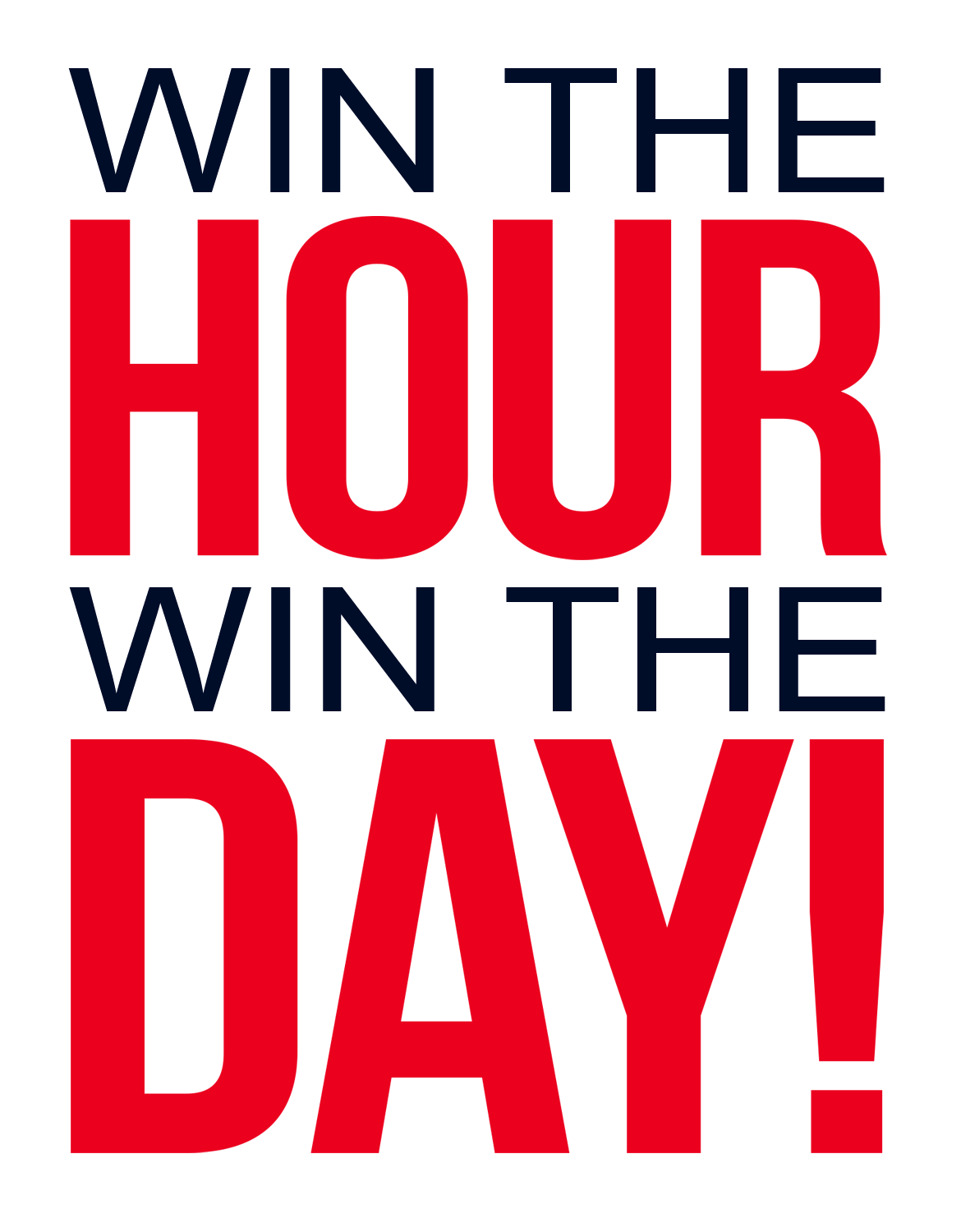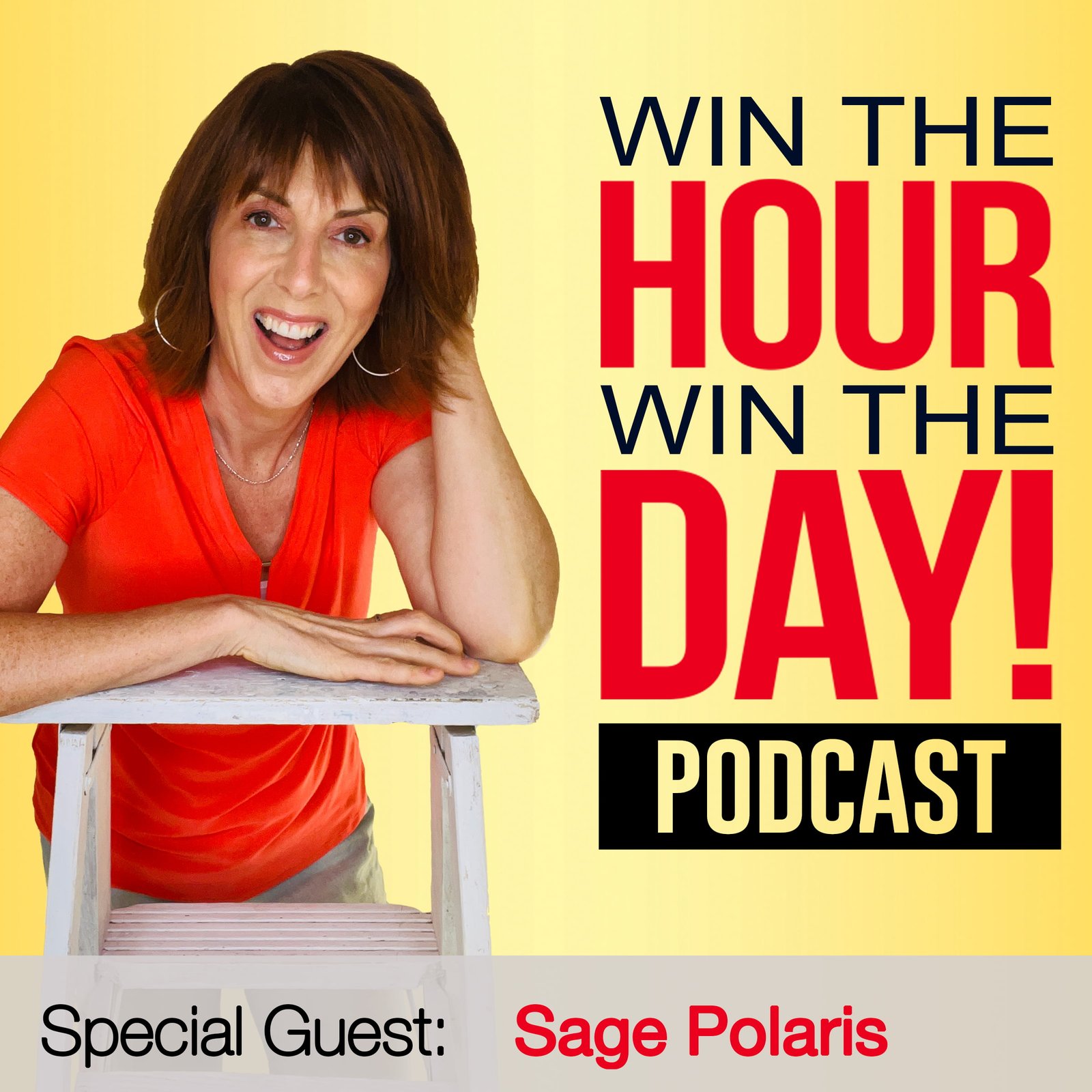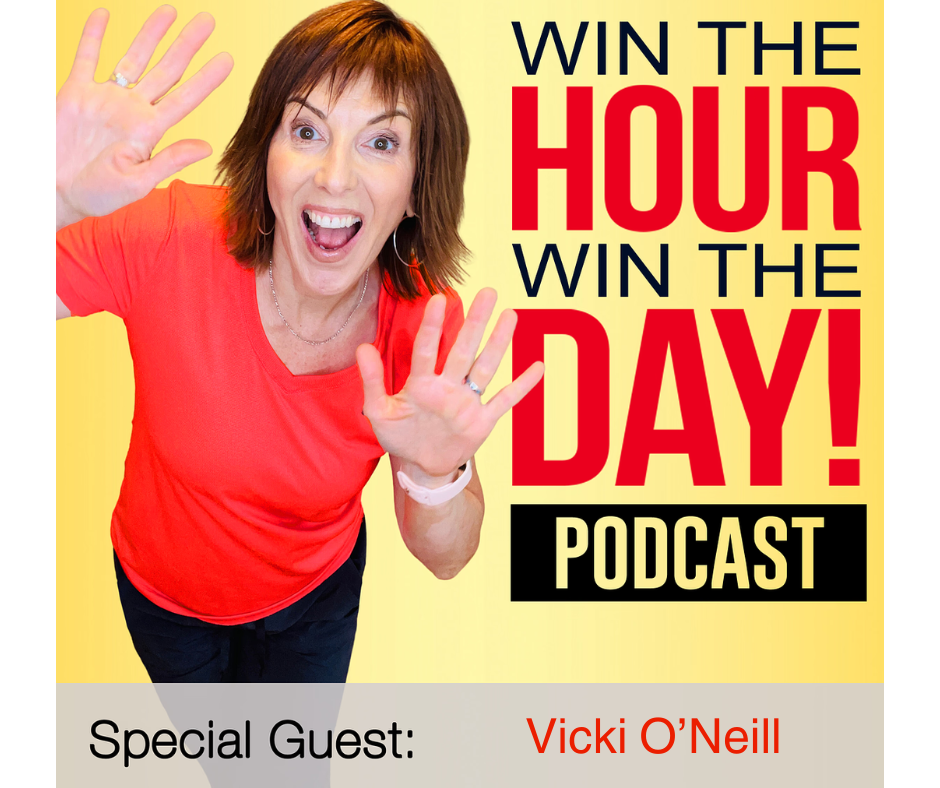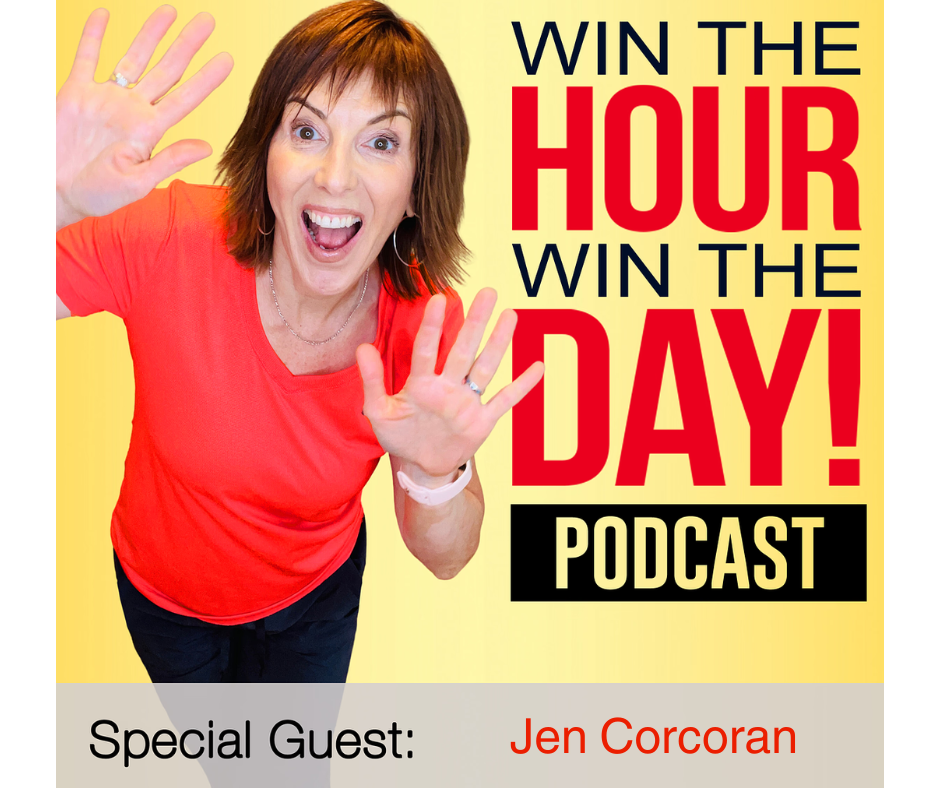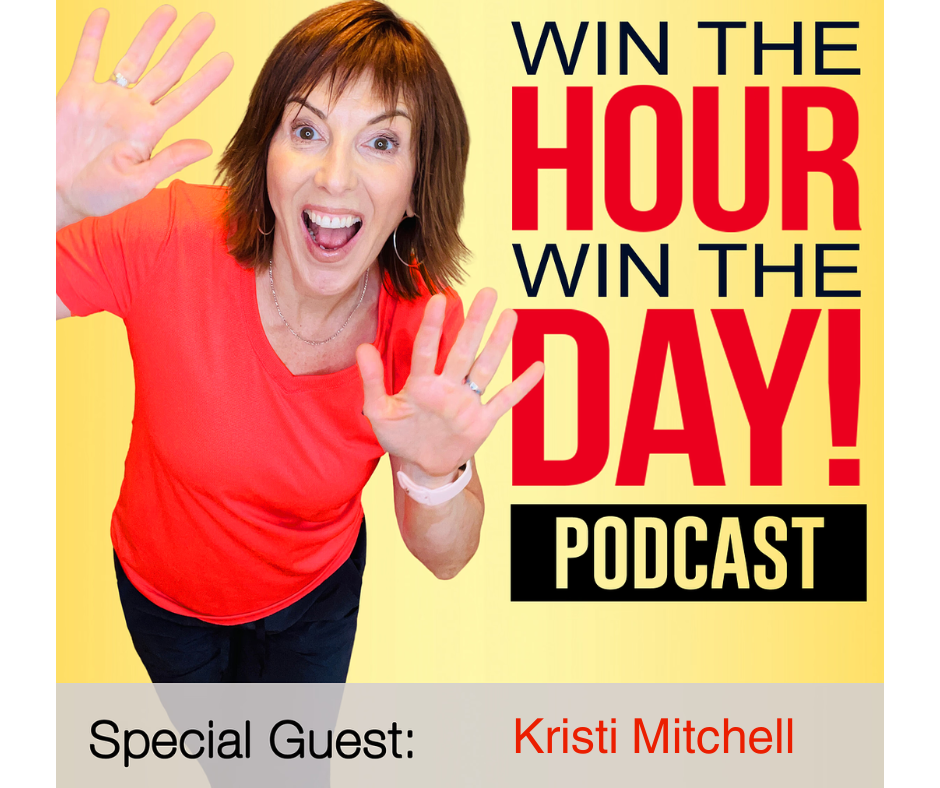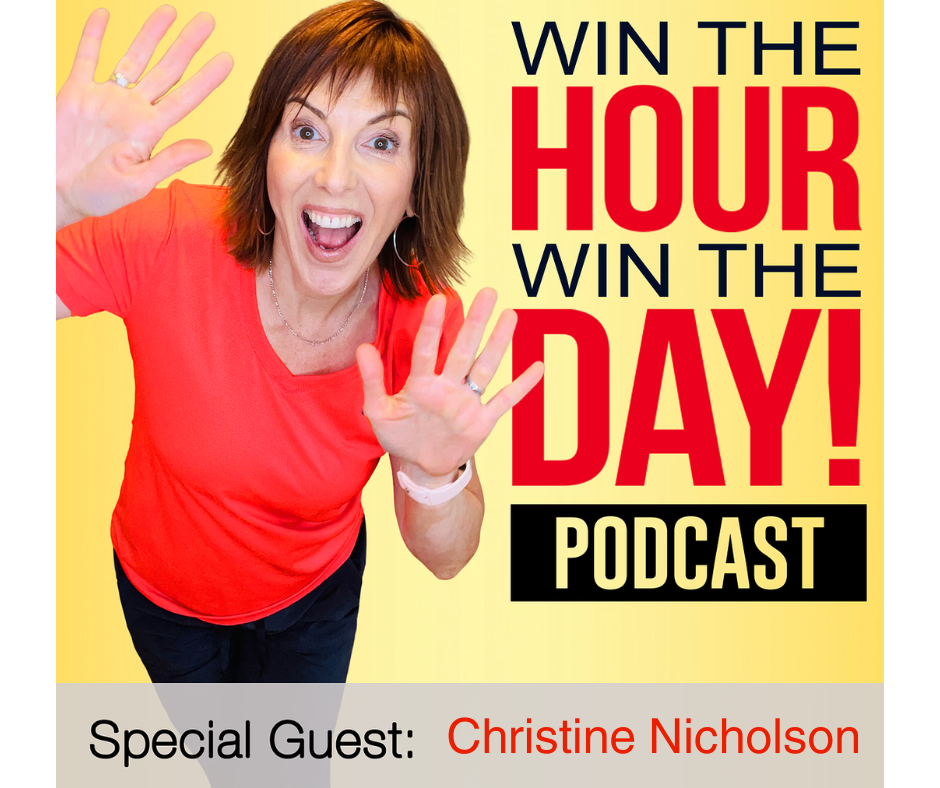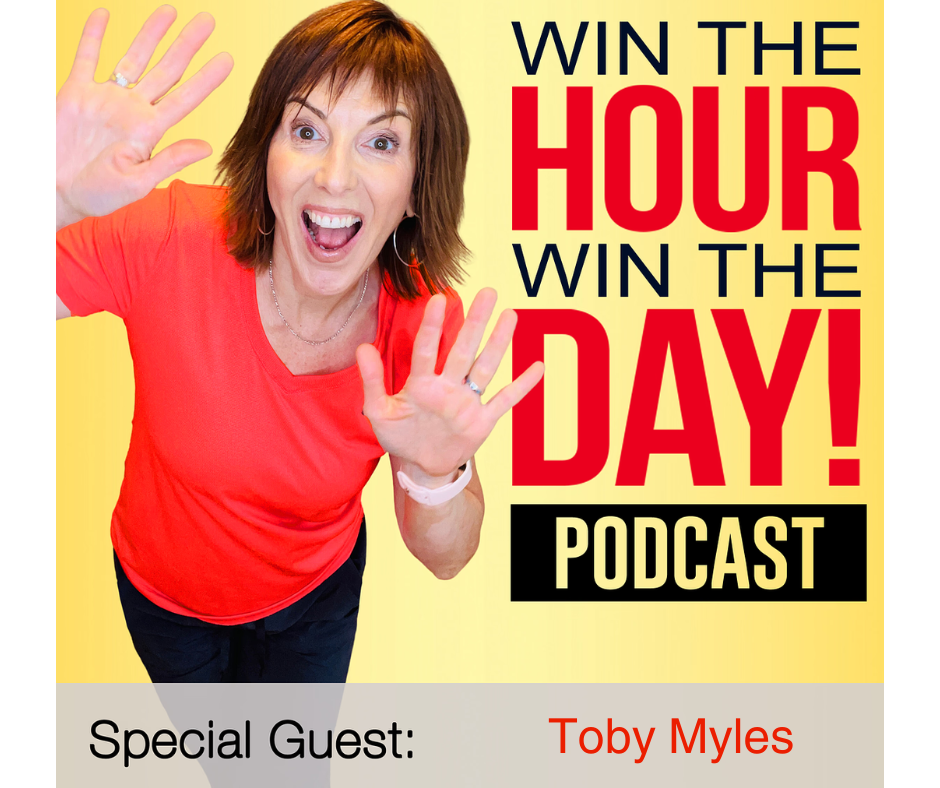Episode Summary
This week’s episode of Win The Hour, Win The Day Podcast is sponsored by Win The Hour, Win The Day’s Signature Coaching Program the Winners Circle. Kris Ward who helps entrepreneurs to stop working so hard interviews, Sage Polaris.
Sage Polaris breaks down copywriting in a unique and memorable way.
Learn:
-What the Simpson’s TV characters have to do with good copywriting.
-How to write persuasive copy for a variety of audiences
-Why email copy outperforms social media
-How to leverage your copy to grow your business….
And MUCH more!!!
W.I.N Time Back Quiz
https://bit.ly/WinTheHourWinTheDayScoreCard
Win The Hour, Win The Day! www.winthehourwintheday.com
Podcast: Win The Hour, Win The Day Podcast
Facebook: https://www.facebook.com/winthehourwintheday/
LinkedIn: https://www.linkedin.com/company/win-the-hour-win-the-day-podcast
Win The Hour, Win The Day Winners Circle: https://winthehourwintheday.com/winners-circle-masterclass
You can find Sage Polaris at:
Website: sagepolaris.com/krisrocks
Win The Hour Win The Day
https://winthehourwintheday.com
Sage Polaris Podcast Transcription
[00:00:00] Kris Ward: Hey everyone. Welcome to another episode of Win the Hour, when The Day. I am your host, Kris Ward.
[00:00:04] And today we have Sage Polaris in the house. She is the copywriter to the stars, and I have to say I have been thoroughly impressed with her and wait till you hear why it’s really gonna change how you see copy, and you’re gonna have all kinds of fun while you learn an amazing amount. So welcome to the show, Sage.
[00:00:24] Sage Polaris: Thank you for having me, Kris. I’m excited to be here.
[00:00:28] Kris Ward: Okay. Let’s… we love just to get to it here and dive in and really just no fluff. Big results. So you talk about writing your copy based on your personality, correct?
[00:00:41] Sage Polaris: . Yep.
[00:00:42] Kris Ward: And then my favorite part, I’m so envious of this as you break that down to the four characters of the Simpson.
[00:00:50] Sage Polaris: Exactly. It’s so fun.
[00:00:52] Kris Ward: ‘Now. It is fun. Now, I think in total I’ve maybe seen 10 minutes of the Simpsons over the years, but I still know who they are and if nothing else, I certainly can still quote commercials or funny things that happened on the show. So it really, you have to know who they are, even if you don’t watch it.
[00:01:08] And I think you do a really impressive job of not just explain to us our copy personalities, but doing like an excellent, I don’t know. It’s a great role modeling of showing us how to make great copy memorable.
[00:01:24] Sage Polaris: Thank you. Yeah, it’s super fun. And I created this because if you think about it, the show, the Simpsons has been on for over two decades now, and I think it’s still going.
[00:01:36] Kris Ward: Yeah.
[00:01:37] Sage Polaris: So it’s not necessarily that you have to know the show to get what we’re about to talk about, but it’s more about the characters are so relatable. Like even if you don’t really watch the show, you know about the characters, right?
[00:01:49] Kris Ward: Yeah.
[00:01:49] Sage Polaris: So that’s what we’re gonna talk about today.
[00:01:51] Kris Ward: A hundred percent. Okay. Where do you wanna start? Take us, guide us.
[00:01:54] Sage Polaris: I love it. Okay, so we’re gonna talk about these four characters from the show, and you must invite them to every time you go to make an offer or you have a launch, and…
[00:02:06] Kris Ward: Okay
[00:02:07] Sage Polaris: The reason we use these characters is to understand that there’s actually four buyer types
[00:02:12] Kris Ward: Okay?
[00:02:12] Sage Polaris: When people make a buying decision, they often relate to one of these characters I’m about to share with you. So we’ll start with the first one, which is Homer, and he is the fun-loving decision maker. So when he lands on your sales page or reads your email, he is looking for fun and funny things in your copy.
[00:02:33] So music, lyrics, puns. Those things attract his attention and keep him reading and keep him engaged in what you’re doing right. You may have a more buttoned up brand that wouldn’t lean into this particular personality type, but most people do. Most people want all four types. And occasionally you might say no, that’s not specifically for my audience, but.
[00:02:58] That being said, I love the Homers, the fun-loving folks, cuz they make it a party when they are a part of your community. .
[00:03:04] Kris Ward: And also, let me jump in there though, even if you would describe yourself as buttoned up. I have two things I wanna say to that. One is, you can think, no, I’m buttoned up and I have a really high-end client base, or, high-end professionals and we have all, if you’ve learned nothing else, we learn they’re humans that like to have fun too, right?
[00:03:22] Sage Polaris: Yes.
[00:03:23] Kris Ward: So don’t just because they pay for big ticket items or something, don’t assume that they’re excluded from humor. And then also too, what is humor to you? It’s that bandwidth of humor, it’s like I always say, if I went to the hairdresser and said, I wanted a wild haircut, she might thin out my bang if my sister said that she might come home with blue hair, because her definition of wild and my definition of wild are very different, right?
[00:03:49] So also, so I wanna support you on that, that the homer character of who to write to, fun-loving decision maker, having more fun. Fun is all relative. So don’t exclude that just because you think you’re the nature of your service is a little bit more serious.
[00:04:04] Sage Polaris: Yeah, a hundred percent. So you get to play with that for sure. Yeah. The next character I wanna share with everyone is Bart. So Bart is the fast decision maker, the born leaders, the CEOs of the world, and they may find themselves to be more buttoned up for sure. C-Suite executives, those types of folks. However, when they land on your sales page, they are very much, they make a decision from their gut, like they already know they wanna work with you.
[00:04:28] And the mistake I see people make is put their button to join further down on the page. Don’t bury your buttons, cuz the Barts of the world, they wanna click and buy right away. Or you wait to share the link for the thing that you’re offering. If you’re announcing a new digital product, let’s say, or a new offer for service-based clients, if there’s a link for them to either book a call with you or to buy the product.
[00:04:52] Do not put that further down. You’ll have several links throughout the email, but for the Barts of the world, you wanna have a link right at the top because they already know they’re never gonna read your whole email. They’re scanners, they go fast.
[00:05:03] Kris Ward: Yeah.
[00:05:03] Sage Polaris: So give them that action right away.
[00:05:05] Kris Ward: Yeah. And so let’s back up for a second too. When we talk about copy, maybe we should define that too. Is it, sometimes we. Get limited in our thinking. I think we’re talking about some big launch and some big sales page. Copy can be, on social media, it can be in your weekly email, it could be in anything, copy is the written word. We’re trying to get someone to take an action.
[00:05:27] Sage Polaris: A hundred percent copy is also like you texting your partner to walk the dog for you that day.
[00:05:31] Kris Ward: . . Oh, that makes sense. Yeah. . Okay.
[00:05:34] Sage Polaris: It’s really using persuasion to get people to make decisions, right? That was for the Barts, those faster decision makers.
[00:05:41] Now, like some people only sell to fast decision makers, so that’s a rare case where you would wanna exclude the others because some of these characters I’m gonna share next. They don’t wanna be slowed down by people who make slower decisions. Like that’s not the type of room they wanna be in. So I’ll share actually Lisa as the next one.
[00:06:00] Kris Ward: Okay.
[00:06:00] Sage Polaris: She is that slower decision maker. So when she comes to your sales page, for example, She totally will read the entire thing. Your whole email, your whole sales page, whatever it is you send to her. It’s just part of her personality. Anything she starts, she likes to finish. So people are like, do I really need like a long sales page or a long email when I’m announcing my product?
[00:06:23] And I’m like, yes, for the leases of the world, they love all of that detail. They’ll read the whole thing and then email you more questions and I realize now that is how they start a sales conversation. That means they wanna buy, right? So the other thing you can do is when they email you those questions, you can copy and paste those and put those in your FAQ section for the next Green Lisa of the world.
[00:06:48] So those slower decision makers, they, the more details you can give them, they love it. They’re very analytical. The other thing is like when they’re looking at the top of your page for your offer or the, your email, the thing they’re thinking. Is this for me, right? So you wanna answer that right at the beginning.
[00:07:08] So if you have an offer you wanna define who the audience is, who’s meant to purchase it specifically for them. So for example, I was doing a live event in Niagara Falls and this is like pre pandemic, but we had a hundred people coming and right at the top of the sales page we said, this is for personal brands and the people who work with them.
[00:07:30] So they knew like we wanted copywriters, service providers, web designers, brands strategists, all those people who work with personal brands, but also people who create brands who are like course creators and all of that. So having that detail right at the top made it really clear to them oh, this is for me, I’m meant to do this.
[00:07:48] Kris Ward: Okay. I think also what you’re bringing up, if I can jump in here, is that you’re saying, it’s so easy for me to say, okay, I make decisions quickly. Like seriously, I’ve bought a house quicker than some people buy groceries, right? And not just one house, numerous houses, right? . Numerous houses over the years.
[00:08:06] Not at the same time. I’m not rolling in it. So then I would think, oh, I get really impatient with the long scroll. It’s doo do, I don’t wanna do that. And to be fair though, a lot of my clients are high energy, fast moving type people, but nonetheless, what you’re really talking about is when we talk about how different people absorb information, so that in the same note, we wanna say, make sure you have a video.
[00:08:28] Make sure you have this and that because people digest information, maybe they wanna show and tell. They digest it in different layers, so your copy should offer them the same opportunity to digest information in different layers just because you like to consume. Information this way doesn’t mean all your audience does.
[00:08:46] So I think that’s the bigger message here as well, that I think a lot of us, I know myself would’ve missed.
[00:08:52] Sage Polaris: Yeah, a hundred percent is that you need to understand how they to make those decisions because they wanna feel safe in making that decision. And by you catering to these different personality types, they feel safer about their buying decision. That’s really what it comes down to.
[00:09:06] Kris Ward: And I think what it comes down to though, is giving these options for the different personality types to consume that versus us deciding ahead of time, oh, this is the people are going to be consuming it. They’re like me, or whatever. So making those decision opportunities in different styles just broadened your net.
[00:09:25] Sage Polaris: A hundred percent. I love how you said that. Well done. And we have one other personality type. This is the fourth and final one that I wanna share with you.
[00:09:33] Kris Ward: Okay.
[00:09:33] Sage Polaris: So you identify as a bart, Kris, is that right?
[00:09:35] Kris Ward: Probably, although he doesn’t seem like a lot of depth there, but go ahead. Sure. You know what I remember about Bart and I’ve seen again, I don’t think 10 whole minutes of the Simpsons ever, but what I do remember is I was walking through the room when something in my family was watching it and Bart fell off something like a house or something. It was first time in a cartoon where they show him on the ground and his leg was broken. And I was like, oh, that’s interesting. We never did that before in cartoons, right?
[00:10:01] They hooked, just go off a cliff. But no, he fell and he had a broken leg. So I always remember that he was the first cartoon that needed a cast. I love that.
[00:10:09] Sage Polaris: Yeah. Yeah. I do remember him getting a cast, actually. Yeah. I was gonna say too, if you don’t feel like you connected with the first three, we can have multiple of these characters in our personality, right?
[00:10:19] Kris Ward: Okay.
[00:10:20] Sage Polaris: And our way that we relate to things might change based on the price point. There are little nuances, right? To how we make decisions, so this fourth character, if you haven’t identified with the first three to our listeners Marge, she is the deep connection decision maker.
[00:10:34] You’re like, there’s not a lot of depth with Bart. So there is someone who loves the deeper connection and the Marges of the world. They’re really interesting. For one they’re very visual, right? So they love beautiful branded photography. They love video. If you have a video on your page, yeah, they like to cuz it makes them feel more deeply connected to you.
[00:10:53] They also love your story. So if there’s a section of your page or an email that you’re writing that shares some of your story, those deeper connection decision makers, the Marges of the world will just soak that up. And interestingly about them that I learned over time is that they also for example, with that live event I did in Niagara Falls, they will invite their friends.
[00:11:15] So if you have an offer where it’s bring a friend for a discounted price or buy one, get one free, and then they offer it to their friend, right? So the Marges are wonderful in that way because they will help you sell, like they’ll take care of the selling with you.
[00:11:32] Kris Ward: Yeah, that’s interesting cuz I would identify where I do like to see a video and I do like to hear the story behind it.
[00:11:38] So you’re right, there’s different and there’s different opportunities. They’re funny enough, like two of my houses I bought like crazy quick, like super crazy quick. But yet I went out one time. God have mercy on my soul. Our washer and dryer, our washer broke on a Tuesday night, so we just went doo do to the hardware store.
[00:11:55] I thought we’d get a washer. And in fairness, I will blame them, not myself. But there, this was when they switched to the front load and all of a sudden washing machines became like rocket chips. And there was like so many features that you just, and you gave you a headache. And three weeks later we’re still like, we have to make a decision.
[00:12:10] Like it was just too much coming at us and you. But that was a confused shopper. Never buys. But it took me three weeks to buy the gosh darn washer and an hour to buy a house. So you’re right. There are different experiences, whether it’s because of the seller or the price point or whatever commitment you have, you could be in different faucets of these different characters.
[00:12:33] Sage Polaris: Yeah, exactly. So it’s good to know that and you can actually take there’s a quiz that you can take. It’s called the DISC-based Personality System. And that’s really what this is based off of. So Eric Thomas is the person I always like to recommend that you look him up cuz he teaches disc in depth.
[00:12:49] But basically if you think about these characters all relate to those personalities from that quiz. And so if you wanna know what are, what strengths do you have in these different characters that we’ve talked about, that’s a way to find it out. So it’s really fun when you start to realize oh, the reds of the world, the Barts right from disc they are great starters, horrible finishers. So they work really good with the greens, the leases of the world, because they love to start and finish things, right? So then you can start to pair people together based on their strengths and knowing your own strengths as well. And just knowing we all have all four characters in us.
[00:13:28] Kris Ward: Okay?
[00:13:29] Sage Polaris: It’s just one is more dominant than the other based on what’s going on at the time.
[00:13:33] Kris Ward: Okay. So this does add a layer and a depth to copywriting that I had never given any consideration before cuz it was just like, oh, here, here is my message. Let’s get this thing out and done because it’s hanging over my head.
[00:13:47] Let’s get it out there. And so not understanding, and I really truly did think that one piece of copy had one personality, but that we can combine all these things into it, allowing for people to graze and accumulate what works for them. So that is something I’ve never considered before.
[00:14:05] Sage Polaris: Yeah. And even things like, people ask me, do I really need so many emails when I’m putting a new offer out there? And for the homers of the world, they are the type who wanna be wooed. They want multiple emails. They want to hear about the offer more than once before they make a decision, right? So there’s these fun things that you start to realize, like in a launch, why do things work the way they work?
[00:14:28] Or if you’re a service-based business and you’re making an offer to your community, like, why do you wanna follow these different tenants that we’ve talked about? And it’s because when you understand these personalities and how they interact with your emails or your sales page or whatever it is, like you start to realize, oh, I want that for those personality types.
[00:14:49] Instead of feeling like, a lot of people are like, if I send too many emails, I’m gonna alienate my audience. They’re never gonna buy from me. And I’m like, no, there’s somebody who wants all those reminders.
[00:14:59] Kris Ward: Yeah, you’re so right. I know there’s times where I will be considering something and I really it’s ridiculous.
[00:15:05] I’ll think, oh let’s see what happens there. Leave it up to the email gods and then when I get the second or third email, I’m like, all right, okay, let’s look at that again. Cuz it keeps showing up in my inbox. Let me, yeah, I’ve been pondering because lots of times I make, quick decisions.
[00:15:18] But if I really not just not sure about the purchase. There’s, and let me sit on it. It’s on a it’s, I’m not sure I want that. So it’s not about making a quick decision. Like I’m just not sure I can justify wanting or needing that. So then I think, oh, let’s see what the email God send us then, oh, there it is again.
[00:15:32] Maybe I am supposed to buy that. It is interesting to hear. I make these big decisions but I know too, now that you say that, we all think that for a second, I don’t wanna annoy somebody and send it all these emails, which at the end of the day, they could just not open them.
[00:15:46] Sage Polaris: Yeah. Yeah, a hundred percent. They’re not meant to open every single email. The leases might just, cuz that’s their personality type. .
[00:15:54] Kris Ward: Yeah.
[00:15:55] Sage Polaris: But just keep that in mind, like it’s totally fine. They, I look at my open rates. And specific to subscribers sometimes, and I totally notice they don’t open everything I send.
[00:16:05] But that also case in point is a reason to send more emails is to make sure that they see the offer, right? Because they might not catch it. Whatever’s going on in their life that week, they may not catch it.
[00:16:16] Kris Ward: Hold on. That’s very simple but profound and nobody said it to me that way. That is a really good point.
[00:16:22] If you’re trying to promote something, then the whole reason we all know that you’re not going to get like in a million years, a hundred percent open email rate. Like I think 50% is nuts. Like I think what is the, a good open rate, like three to 5%.
[00:16:38] Sage Polaris: Oh, that’s more click through rates, meaning they click
[00:16:40] Kris Ward: Yeah, you’re right. Okay. I’m confusing things, so whatever it is, we know it’s not a hundred percent, we know it’s not likely 50%. So depending on the platform, whether it’s a email broadcast or a click through rate or anything like that, you are right in the fact that the more emails means the more people that are going to trip through it, and stumble upon it and then open it. So it does serve us in that way versus, oh, I don’t wanna annoy them and send another one. It’s oh, they, you missed the first one. I’ll send you another one.
[00:17:10] Sage Polaris: Yeah. And I will make a case for comparing like social media. About two to 4% of your audience will see your posts.
[00:17:18] Versus email open rates are typically between 19 and 30%. Some people go higher than that. So those are reasons why you need multiple marketing channels for sure. I goes a little bit deeper, but it’s still important to understand because the visibility of what you’re doing is different on different channels.
[00:17:36] But also, email tends to be stronger in terms of actually getting people to see your content, cuz they subscribe to it. .
[00:17:45] Kris Ward: Those are all good reminders. And also, up until recently I was really hot and cold with the emails. I’m like, ah, they know I’m here, whatever, why am I sending these?
[00:17:53] And I’d be really good like a diet for three weeks. I’m good and I’m not good. But you’re right, they did subscribe to it. They do know me and studies do show that the Oprah me for email is higher than somebody viewing you on a platform. So just another good reminder to be taking this more serious.
[00:18:09] . Yeah. Yeah. Sometimes I say to people, oh, I forgot. I knew that. You’re right. I knew that and I forgot. I knew it. I forgot why that was important.
[00:18:16] Sage Polaris: I love it. And when you start to get the results from your email, it becomes fun, right? Like you start to see what your work is. All the work you’ve put into communicating.
[00:18:26] When you get people replying back to you buying your things, then it starts to become more enjoyable too.
[00:18:32] Kris Ward: Of course it does. Yes. Doesn’t it? Yes. Thank you for doing that. Yes. Some people start buying from me more. It’s more fun. But I think too, also, you give such a good example here. When I looked at this, I thought here’s a broadcast in itself and copy I could be working on, I could be talking about whatever.
[00:18:49] I could say, Hey, with my client base, okay, people that I work best with is Anne might be somebody that constantly thinks she’s going, like we could be doing our own prototype in our own broadcast. So I could be describing, maybe you’re like Steve and you’re always stressed out and you think once you get past this next thing, your business will be different.
[00:19:07] But how long you been saying that? Or maybe you’re like Anna, who’s always in a rush and thinks speed is serving her well, but she doesn’t realize she’s skimming over things. So I could be talking to my audience, even if we’re not as brilliant as you tying it into The Simpsons. We could have prototypes that could be describing that to our users in our own broadcasts, making them, using this formula of excellence in your copy and transferring it to things that we do.
[00:19:34] Yes. I love
[00:19:34] Sage Polaris: that so much. A hundred percent. And then they’ll be like, she sees me, she’s inside.
[00:19:39] Kris Ward: Yeah. . I see that you’re good at what you do and we need to emulate that. Awesome. Okay, so what are some other things that you think traditionally we missed the boat on with copy?
[00:19:49] Sage Polaris: Yeah. We talked about the sales page, for example, having a button at the top.
[00:19:55] Kris Ward: Yeah.
[00:19:55] Sage Polaris: So another thing you can do for the Barts of the world is right near your button. You can have a testimonial. And
[00:20:04] Kris Ward: Oh, okay.
[00:20:05] Sage Polaris: I would try to pick and this just helps in general for people to click your button, like those parts of the world, they’re already fast decision makers. They already in their gut know they wanna work with you.
[00:20:14] Like we mentioned before. And if you add a testimonial particularly of like a household name, they might recognize they’re even more likely to buy your thing.
[00:20:26] Kris Ward: Okay.
[00:20:26] Sage Polaris: It’s really fun to play with that. For example, let’s say we wanted to sell something to Oprah and we had a testimonial from Gail, her best friend, next to the buttons.
[00:20:37] She’ll be way more likely to purchase that thing. Funny enough, though, I was talking to someone else who’s self-identified as a BART, and he was saying, yeah, and if you put a testimonial of my competition, I will wanna buy it right away. I wanna buy everything. My comp, quote, unquote. Whether or not you believe in competition.
[00:20:56] That’s how he described it.
[00:20:57] Kris Ward: Yeah. Yeah. .
[00:20:59] Sage Polaris: But I love that, I was like, oh, okay. This is how you’re thinking.
[00:21:03] Kris Ward: Yeah, that makes a good point. Okay. All right. Wow. Wow. Lots to think of, I think too. What we’ve done here is copy tends to be a heavy word, and it’s oh, I have to write this copy and I have to do this.
[00:21:17] And it’s there’s so much to it and it’s the thing is it of slows down the bigger project, getting the email out, doing whatever. And I think what you’re teaching us is break it down, make it simple, make it fun, and understand, you know what it’s not one academic piece that we’re attracting different people at different points of the journey.
[00:21:35] And so acknowledge that and have different pieces to it. A little bit of a buffet when your family shows up for dinner, on a whatever Thanksgiving or what have you, he’s ah, you’re not all gonna everything on the table, but you can pick what you want.
[00:21:46] Sage Polaris: Yes, I love that. And when you’re first putting a product out there, having that buffet of options for all four character types that we talked about who are making buying decisions, I do like that initial email that announces the product to appeal to all four.
[00:22:02] , but then throughout your sequence, you don’t have to peel to all four characters with every email. Like you might have an email that’s very driven for the blues. Okay. Another email that’s very much for the greens, another email that’s very much for the yellows. So you know, you can play with this and start to see what feels good to you and see what your audience responds to as well. People
[00:22:22] Kris Ward: And the green and the yellows and the blues, those are the ones that we have relabeled, the bartley Sent Homer and stuff like that.
[00:22:27] Sage Polaris: Exactly.
[00:22:27] Kris Ward: So we’re tying that together. Perfect.
[00:22:29] Sage Polaris: Thank you.
[00:22:30] Kris Ward: Awesome. Awesome. All right. Where can people find more of your excellence, Sage? How can they get on your email list and learn from you?
[00:22:37] Sage Polaris: Oh, come play with me. I’m so excited. Thank you for this opportunity, by the way, Kris. It’s so fun chatting with you. So if you go to sagepolaris.com/krisrocks
[00:22:48] Kris Ward: Ah, cool. Make sure that’s in the show notes, right? Yeah.
[00:22:53] Sage Polaris: Then you’ll be able to get my triple email open rates.
[00:22:56] Kris Ward: Okay?
[00:22:57] Sage Polaris: So that will allow you to copy, paste and personalize three emails.
[00:23:03] Kris Ward: Okay?
[00:23:03] Sage Polaris: If you have done what Kris mentioned earlier and maybe you’ve ghosted your list here and there, it’s okay cuz you can use these, send them to them, it will help you get clear on who’s actually reading your emails. It’ll help your open rates, which helps with deliverability. And you can also, if you’ve had an email list for a while, you can use those three emails to then if people are not engaging, like they haven’t opened your emails in the last 90 days, it’ll get you really clear on who you can remove from your list because you are paying for those subscribers who are potentially not looking at any of your emails.
[00:23:38] So I love this tool. It’s like the entry point to really getting clear about your email marketing channel. And so yeah, go to sagepolaris.com/krisrocks. You can grab those emails and be on your way to tripling your email open rates.
[00:23:54] Kris Ward: That sounds like a plan for everybody. Okay. We will definitely make sure that’s in the show notes. Everyone else will see you in the next episode. And Sage, thank you so much.
[00:24:03] Sage Polaris: It’s my pleasure. Thank you for having me, Kris.
